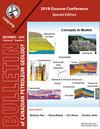加拿大西部沉积盆地油砂区次生生物气的识别与来源
Q3 Earth and Planetary Sciences
引用次数: 6
摘要
加拿大西部沉积盆地油砂沉积来源于阿尔伯塔省西南部的轻质油,这些轻质油向北和向东运移了100多公里。生物降解是将原始轻质原油转化为重油和沥青的主要过程,尽管存在其他的改变机制。生物降解水平从西南部(非生物降解)到东北部(极度生物降解)呈上升趋势,并与储集层古温度降低有关,古温度在控制生物降解机制中起主要作用。单个储层柱内的组分梯度和可变生物降解表明,水腿尺寸是生物降解程度和油物性垂直变化的关键局部控制因素。次生生物气是重油和沥青厌氧生物降解形成的副产物,“沥青上气”是沥青聚集的共同特征。观测到的贫13c甲烷和富13c CO2为产甲烷生物降解和生物源甲烷生成提供了直接证据。在伴生地层水的地球化学中发现了厌氧生物降解的补充证据。利用C2+烷烃组分的同位素特征可以很容易地将厌氧生物降解相关气体与原生生物气体区分开来。根据观察到的原油生物降解水平、产甲烷烷烃生物降解的化学计量学,并假设二氧化碳转化为甲烷的速率,这些油气聚集的生物降解产生了约141.3 × 1012 m3 (4991 Tcf)的次生生物甲烷。然而,评估目前在地下保存了多少次生生物气是困难的。独立于生物降解研究之前进行的天然气资源评估表明,McMurray组的天然气储量预计约为58.7 × 109立方米,而与油砂区(Athabasca和Lloydminster)相关的所有Mannville Group储层的天然气储量预计约为608.5 × 109立方米。即使对保留气体的估计是保守的,很明显,在生物降解过程中产生的次生生物甲烷绝大多数都泄漏到覆盖层中,溶解在地层水中,或逃逸到大气中。本文章由计算机程序翻译,如有差异,请以英文原文为准。
Recognition and sources of secondary biogenic gases in the oil sand areas, Western Canada Sedimentary Basin
Abstract Western Canada Sedimentary Basin oil sand deposits are derived from light oils generated in southwestern Alberta, which migrated to the north and east for more than 100 km. Biodegradation is the primary process that transformed the original light crude oil into heavy oil and bitumen, although other alteration mechanisms were present. Biodegradation levels increase from the southwest (non-biodegraded) to the northeast (extremely biodegraded) and are associated with decreasing reservoir paleo-temperature that plays the primary role in controlling the biodegradation regime. Compositional gradients and variable biodegradation within a single reservoir column indicate that water-leg size is a critical local control on vertical variations of biodegradation degree and oil physical properties. Secondary biogenic gas is a by-product of the formation of heavy oils and bitumens by anaerobic biodegradation, and “gas over bitumen” is a common feature of the bitumen accumulations. Observed 13C-depleted methane and 13C-enriched CO2 provides direct evidence for methanogenic biodegradation and biogenic methane generation. Supplemental evidence for anaerobic biodegradation is found in the geochemistry of associated formation water. The gases associated with anaerobic biodegradation are easily differentiated from primary biogenic gases using the isotopic signature of C2+ alkane components. Based on the observed crude oil biodegradation levels, the stoichiometry of methanogenic alkane biodegradation, and assuming a conversion rate of carbon dioxide to methane, approximately 141.3 × 1012 m3 (4991 Tcf) of secondary biogenic methane was generated accompanying the biodegradation of these petroleum accumulations. However, assessing how much secondary biogenic gas is preserved currently in the subsurface is difficult. Gas resource assessments performed prior to and independent of biodegradation studies suggests that McMurray Formation is expected to contain approximately 58.7 × 109 m3 natural gas in place and that all Mannville Group reservoirs associated with the oil sand regions (Athabasca and Lloydminster) are expected to contain approximately 608.5 × 109 m3 of raw gas in place. Even if the estimates of retained gas are conservative, it is apparent that the vast majority of the secondary biogenic methane generated during biodegradation is leaked into the overburden, dissolved in formation water, or escaped into the atmosphere.
求助全文
通过发布文献求助,成功后即可免费获取论文全文。
去求助
来源期刊

Bullentin of Canadian Petroleum Geology
Earth and Planetary Sciences-Geochemistry and Petrology
CiteScore
2.50
自引率
0.00%
发文量
0
期刊介绍:
The Bulletin of Canadian Petroleum Geology is a peer-reviewed scientific journal published four times a year. Founded in 1953, the BCPG aims to be the journal of record for papers dealing with all aspects of petroleum geology, broadly conceived, with a particularly (though not exclusively) Canadian focus. International submissions are encouraged, especially where a connection can be made to Canadian examples.
 求助内容:
求助内容: 应助结果提醒方式:
应助结果提醒方式:


